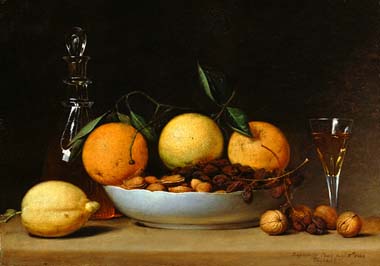Best American Still Life Painters
 From Conservapedia
From Conservapedia 
Best American Still Life Painters
"While the Peale family of Philadelphia produced extraordinary still life paintings during the 18th century, the next generations of artists added their own mark to this important tradition." [1]
Contents
- 1 James Peale
- 2 Raphaelle Peale
- 3 Charles Bird King
- 4 John F. Francis
- 5 Severin Roesen
- 6 Martin Johnson Heade
- 7 Andrew John Henry
- 8 Paul LaCroix
- 9 George Cochran Lambdin
- 10 John LaFarge
- 11 Richard LaBarre Goodwin
- 12 William Harnet
- 13 William Merritt Chase
- 14 Emil Carlsen
- 15 John Frederick Peto
- 16 Charles A. Meurer
- 17 Georgia O'Keeffe
- 18 Preston Dickinson
- 19 See also
- 20 External links
- 21 References
James Peale[edit]
(1749 – 1831) brother of portrait painter Charles Willson Peale, and considered one of the finest miniaturists of the Federal Era, James Peale also practiced landscape.


Raphaelle Peale[edit]
(1774–1825) he was America's first professional still-life painter.

A Dessert (Still Life with Lemons and Oranges), 1814.
Charles Bird King[edit]
(1785–1862) also known for his famous paintings of American Indian chiefs.


John F. Francis[edit]
(1808–1886) born in Philadelphia, Francis is best known for his luncheon and dessert still life paintings.



Severin Roesen[edit]
(1816–ca. 1872) is most famous for his abundant fruit and flower still lifes and is today recognized as one of the major American still-life painters of the mid-nineteenth century. [1]

Martin Johnson Heade[edit]
(1819-1904), a Hudson River School painter.

Andrew John Henry[edit]
(1826-1888). Henry's still lifes are on subjects like: bunches of grapes and oysters.

Paul LaCroix[edit]
(1827-1869). Paintings by LaCroix hang in world best museums like: the Brooklyn Museum, New York City, Springfield Museum of Art, Ohio, and the Thyssen-Bornemisza Museum, Madrid.



George Cochran Lambdin[edit]
(1830-1896) focused on the study and painting of roses in vases, arrangements, or against stark backgrounds.



John LaFarge[edit]
(1835-1910). Among his many commissions, in 1876, the mural decoration of the Trinity Church in Boston; He admired the formality and patterning of Japanese art. [2] In the painting of still-life and flowers he followed a method of his own, based on the principles of the Pre-Raphaelites. [3]

Red Hollyhocks.
Richard LaBarre Goodwin[edit]
(1840-1910), a portrait and still-life painter; Goodwin's still-life paintings are of a type known as trompe l'oeil (French for "fool the eye") because the meticulously rendered objects. [4]


William Harnet[edit]
(1848-1892) preferred, for his still life subjects, musical instruments, hunted animals and firearms.



William Merritt Chase[edit]
(1849-1916) was a prolific painter with more than 2000 works, included still lifes, portraits, and landscapes.





Emil Carlsen[edit]
(1853-1932), the artist's best-known still life works were of brass or copper pots, undistinguished vessels and vegetables, which were often combined with the morning catch to create simple but graceful kitchen tableaus. [5]



John Frederick Peto[edit]
(Philadelphia, 1854 - Island Heights, New Jersey, 1907), an American trompe l'oeil painter specialized in the nostalgic wall-rack painting. Peto befriended William Harnet. His works are represented in the collections of major museums throughout the US. [6] [7]




Charles A. Meurer[edit]
(1865-1955), a 19th Century American landscape, still life painter. Born in Germany of American parents, Charles Meurer became the last living link to the heyday of the trompe l'oeil painting style. Many of his trompe l'oeil works have reproductions of money, and he has also done painting with hunting motifs that are similar to work by William Michael Harnett, the man credited with founding the trompe l'oeil style in America. [8]



Georgia O'Keeffe[edit]
(1887 - 1986) was a modernist painter. O’Keeffe’s images — often instantly recognizable as her own — include large-scale flowers.


Red Poppy, 1927.

Oriental Poppies, 1928.
Preston Dickinson[edit]
(1889–1930). Dickinson clearly enjoyed the geometry, ambiguous space, and multiple viewpoints of cubism. His still lifes have a grace, a precision, and an elegance that are remarkable. In modern art it is rare to see so high a finish carried out with complete gusto to the end... Still-life subjects gave Dickinson a golden opportunity to revel in his penchant for complex compositional construction, diverse objects, detailed patterning, as well as odd combinations of color.[9]



See also[edit]

- Gallery of American Masterpieces
- American Impressionism Gallery
- Painting Schools
- American landscapes painting
- Contemporary Abstract Painting
- Painting


External links[edit]

- American Still Life Painters.
- Still Life.
- American Still Life Painting, 1800-1900.
References[edit]
- ↑ About American Still Life Painting, 1800-1900.




MAKING ART WITH ART
Categories: [American Painters] [American Painting] [Best]
↧ Download as ZWI file | Last modified: 02/16/2023 07:06:41 | 147 views
☰ Source: https://www.conservapedia.com/Best_American_Still_Life_Painters | License: CC BY-SA 3.0
 ZWI signed:
ZWI signed: KSF
KSF